Travel to Quito
Wednesday, July 9, 2008: Travel to Quito was uneventful. The plane left Miami shortly before 4pm and arrived at the Quito airport just after sunset. This time I traveled business class, which is much more pleasant than coach. It starts with the special line to check your bags, then a special line that takes you right to the front for security. And of course, it's much more comfortable on the plane.
Hotel Sebastian, Quito
Travel to Napo Wildlife Center
Thursday, July 10, 2008:Before breakfast I heard a bird singing that sounded sort of mockingbird-like. Not sure what it was. It might have been Great Thrush. My first bird from Quito was an Eared Dove, soon followed by the ubiquitous Rock Pigeon. A good-sized dark bird became my first lifer: Great Thrush. There's a little park next to the hotel. It had these birds and an old friend: Rufous-collared Sparrow. A bird making a ticking noise kept bothering me, but I couldn't find it at that point.
There was a change of plan, so rather than meet with our guide (Paul Greenfield) for breakfast, we had breakfast on our own. Paul's brother Steve was in town and would also be joining us. The plan was for Juan, who met me at the airport, to come by at 10 to take us to the airport for our flight to Coca.
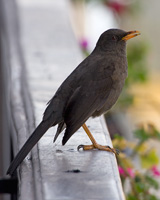 |
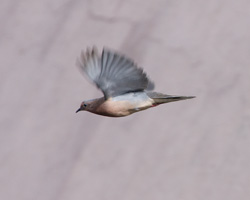 |
 |
| Great Thrush | Eared Dove | Plane to Coca |
|---|
After breakfast, I determined the ticking bird was a hummingbird of some sort (not a hermit). The hummer was even doing some display flights. Eventually I was able to get decent looks and then identified it: Sparkling Violet-ear. Later on, one of the female Great Thrushes (no eyering = female) landed on the balcony railing of a nearby room.
At 10 we left for the airport for our short flight to Coca (officially, Puerto de Francisco de Orellana). The Napo Wildlife Center had a representative at the airport to tag our bags and expedite our travel. They couldn't do anything about the weather, which delayed the flight a bit, and we left Quito shortly after noon. From the El Coca airport, it was only a short ride to the motorcanoes. Some martins and swallows were flying around near the dock. After a short wait, we got on the boat and headed down the river (our luggage travelling separately, bagged for protection against spray and rain).
The Rio Napo
Some birds were seen along the river, including a number of Swallow-winged Puffbirds and a Greater Yellow-headed Vulture (two of which would later been seen perched near the lodge). Other birds seen from the river included Russet-backed Oropendola, White-banded Swallow, Oriole Blackbird, Yellow-rumped Cacique, and White-winged Swallow. Normally, we would have expected to see more birds, but the river level was unusually high.
We stopped twice to drop people off near the village, then headed to the mouth of the creek leading to the lodge. Normally there's a sandbar to maneuver around, but it was inundated. Rather than transfering immediately to the canoes, we spent some time birding the area (called the warehouse).
The high water also erased the boundary between the blackwater of the Añanguyacu creek and the sediment-laden waters of the Napo. The Napo was at flood stage and it's water had backed up into the creek almost to Añangucocha, the lake where the lodge is. The water level would drop several feet during our stay.
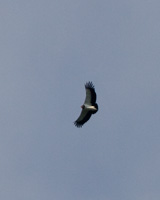 |
 |
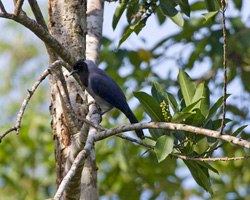 |
| King Vulture | Black-fronted Nunbird | Violaceous Jay |
|---|---|---|
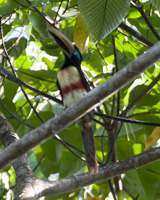 |
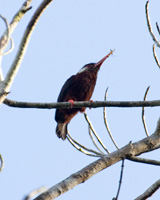 |
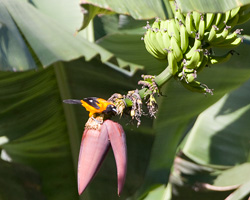 |
| Chestnut-eared Aracari | White-eared Jacamar | Orange-backed Troupial |
I got a number of lifers at the warehouse: Gray-breasted Sabrewing, Black-fronted Nunbird, Chestnut-eared Aracari, Many-banded Aracari, Cream-colored Woodpecker, Scarlet-crowned Barbet, White-eared Jacamar, Cobalt-winged Parakeet, Orange-backed Troupial, and Violaceous Jay. We also saw Social and Gray-capped Flycatchers, Crested and Russet-backed Oropendolas, and Yellow-rumped Cacique. A Thrush-like Wren was repeatedly heard calling.
The Añanguyacu
We then got into the canoes (they now use fiberglass canoes made by another tribe rather than dugouts) and birded our way to the lodge. A nice flock was harrassing a Ferruginous Pygmy Owl. Lifers seen along the way were: Great Jacamar, Red-bellied Macaw, Silvered Antbird, Rufous-rumped Foliage-gleaner, Crowned Slaty-Flycatcher, Rufous-bellied Euphonia, and Gray-headed Tanager.
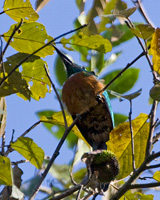 |
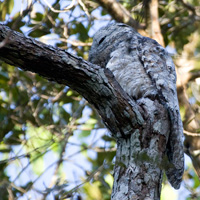 |
| Great Jacamar | Great Potoo |
|---|---|
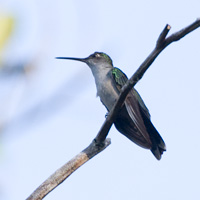 |
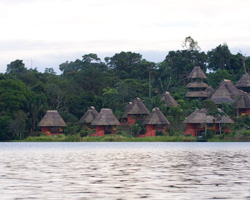 |
| Gray-breasted Sabrewing | Napo Wildlife Center |
After a presentation, dinner, and the list, I went to bed early. I was serenaded to sleep by Pauraques and Limpkin.
Much of the day was travel, so the trip total is still fairly low—45 species including 23 lifers.
Napo Wildlife Center